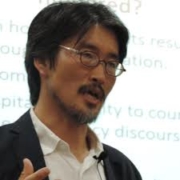Kimmo Kuortti
Finnish Education Export
Today we explore the export of Finnish Education. My guest is Kimmo Kuortti who studies the effects of education export and other forms of education business on the domestic publicly funded education system in Finland.
Kimmo Kuortti is a doctoral researcher at Tampere University. His new article “Repurposing public education: governmental rationality of education export in Finland through public education problematisation” was published in the Journal of Education Policy.
Citation: Kuortti, Kimmo with Will Brehm, FreshEd, 356, podcast audio, June 14, 2024.https://freshedpodcast.com/kuortti/
Will Brehm 0:01
Kimmo Kuortti, welcome to FreshEd.
Kimmo Kuortti 1:10
Thank you.
Will Brehm 1:10
Congratulations on your new article. I found it really insightful and fascinating. And to start today, I’m curious if you could sort of position Finland known around the world for having a supposedly exceptional education system. So, for listeners who might not know too much about Finland, how would you describe this sort of standard understanding of Finnish education as being exceptional?
Kimmo Kuortti 1:31
Thanks, Will. That’s a really good question. It’s complex as well, I think. The situation in Finland -I would start with saying that Finland, for a very long time was fairly homogenous linguistically and culturally. I mean, we are a bilingual country; Finnish and Swedish are the national languages, and Sami is a minority language as well, official language in the northern part of Lapland as well. But by and large, we did not have a very large influx of immigrants, for instance, or guest workers. So, this kind of situation obviously has an effect, or it makes it possible for the education system to function in a particular way, catering for a fairly linguistic and culturally homogenous group. Secondly, Finland has enjoyed a fairly stable democratic development over a fairly long period. I mean, obviously, Finland became independent in 1917 and then the second world war was there, obviously as well. But by and large, it’s been a very stable democratic development, especially since 1917 which has enabled the development of institutions through a democratic process. I mean institutions like the education system. Also, many researchers have pointed out that the state controlled, and coordination of education has been fairly strong over a very long period of time. Once again, combined with a steady development. Reforms as well, of course. I mean especially -Hannu Simola who is a scholar that has written about this. An important part related to education is also the elevation of teacher education to universities in the 70s. And there’s a lot of research on that also, and the effects of that, but it has probably created kind of a strong professional identity of teachers and what is often called science-based teacher education -also a debatable term and development as well. A lot of research has been written on that. But having myself also gone through other teacher education in Finland, I do observe a kind of very strong, positive identity that the teachers have. Teacher’s job -I mean, even primary teachers and secondary school subject teachers has always been fairly well paid. You don’t become rich, but it’s an okay paid job. And I think, finally, one thing that is very important is that there’s been for a long time a trust. Kind of a trust in education as a tool for like social advancement and like an individual’s edification. There’s a very strong belief in that. I mean, I remember my grandmother, who never left her home village in Lapland, where I was born, and she’d never gone to more schooling than, I mean, not even primary school. I think she had like four classes of traveling tutors teaching them to read and write and basic stuff. She was always of the opinion that education is something that is really important, and you should strive to educate yourself. And this kind of trust is very typical then, for the Finnish society. And I mean, all this is part and parcel of what education in Finland has been. Yeah, that’s roughly how I would describe the context of what education is and has been in Finland.
Will Brehm 4:52
And from a lot of sorts of international listeners and the international community more generally, the success of Finnish education was usually documented, sort of, by the Program for International Student Assessment, the PISA scores. And Finland started doing really well on this international examination, which brought a lot of attention to Finland. So, what impact, in a sense, has PISA had on the Finnish education system.
Kimmo Kuortti 5:21
There’s a lot of research on that as well -so, the impact of PISA. And first of all, what many research have said is that PISA has not really had an effect on how Finnish education policy is done. That’s one thing. So, has PISA affected how Finland thinks Finnish education, administration, politicians, how they see education, or whether they, for instance, want to change something. So, the answer is probably not really that much. But however, one thing which it definitely brought, and PISA, was used, let’s put it that way, to create the idea and even the program of the Finnish education export. So, PISA was seen as indication. It was seen that okay, PISA shows that we’ve got a lot of good education, and education quality is good. And it was used as a ground for saying, like, okay, we can create export. We can create products out of this. We can sell education. So, PISA was seen as a ground for that. And then, of course, because of PISA, we especially around 2010 and about that time, a little earlier, a lot of international delegations coming to Finland to learn about why. What’s the secret? How come that Finland, in those PISA studies is ranking so high? So, also interpreted as a sign of demand. So, PISA had a definite effect on the idea at the creation of education export. So, that’s one thing, but it’s really interesting that for Finnish education policy, there is not that much influence. However, I kind of, in my paper say, well, actually there is, and this is my view also in my paper. I’m not really looking at how are Finnish education exporters doing, for instance, right? There are a lot of really interesting studies on that as well. How did Finnish education become exported to Africa, wherever, you know, Asia, a number of places, and what happens there? And there are a lot of really, really good stuff on that. But what I thought is like, Okay, well, has this not had an effect in Finland? What does it do to our domestic system? And there I say, like, Okay, well, I think PISA had an effect in a way, because it was used as a ground. And then I turned towards and look at the Finnish domestic education scene, and what does the education export do there, if you like?
Will Brehm 7:50
And before we dive into that domestic scene -because that is the sort of crux of your paper, and it is really quite interesting- I think it’s maybe valuable to unpack what you mean by this Finnish government’s education export program. Because I would imagine a lot of listeners live in countries that do not have the ability to export their education system, right? Like you are living in a country, you are studying a country that is in this unique position, in many ways, of a handful of countries that actually probably try and export their education system. You’re saying that this is a government program. Can you explain what exactly does that mean in a practical way? How is it a program?
Kimmo Kuortti 8:29
Yeah, absolutely. First of all, Finland, of course, when wanting to export education, is conceptually doing a very similar as some of the let’s call them traditional big education powers in the world; Anglo American countries -USA, Great Britain but also recently, for instance, Germany- are involved in this. However, the way things are organized in those countries, also from the policy point of view, can be very, very different. That hopefully might be something I look into in the future as well. How is it done in different countries? Of course, education export in itself. I also write in my paper that’s a very fuzzy concept in the Finnish context, to what exactly is the education export? It’s all kinds of things. And there’s some policy papers which include, I mean, school furniture counts as education export. Although, I mean, it’s just furniture in a way, but all of a sudden it becomes a pedagogical product; a chair. Which it can be, fine. These are almost philosophical questions, but interesting. I find them very, very interesting too. So, education export is a lot of things in the Finnish context; selling education, also programs, also recruiting international students to Finland, students studying in Finland for a master’s degree, for a bachelor’s degree, typically in programs which are then taught in English in Finland is considered education export as well. It counts in the so-called education export income statistics as education export. But why is it a program? Is also a very good question. How can we call it a program? Well, if we look at the development from about 2010 until now, until today, even we’ve had a series of government documents that have been building on previous documents targeting certain areas in a very continuous manner. It’s been continuing for over a decade now, and the program has, for instance, stressed the need for training public educators in -let’s just call them business skills if you like- training them to understand education as something that you can sell. Training public educators in things like marketing, like productizing your teaching, your education. And this can perhaps continue over a decade, and training programs like that. There’s been five rounds of training programs like that that the government has financed, and that’s why I see there’s a programmatic element in this.
Will Brehm 11:04
And I think it’s a clear example of some of the how this export industry impacts the domestic educational sector. I mean, just that change in discourse is massive, right? All of a sudden, using the logic of business to understand your own work as a public-school teacher is a big shift. I want to dive into some of these domestic issues, but just to get a sense; do we have a sense of how big this export industry is in terms of the economy, like, in terms of impact on GDP?
Kimmo Kuortti 11:33
Yeah, the impact on the Finnish economy -that has been studied. I haven’t seen, actually, an academic, a study on any of that so far. However, the government has ordered a report, and I think the latest report was in 2022. Well, that’s already a couple of years old, but at that point -and once again, this is also interesting, the way it’s counted, and what is said about the impact, which the impact is different or can be different than, let’s say, the turnover, some of what the companies do. So, the impact is counted to be, in that report, about 1 billion Euros in gross national product, which represents about 0.5% of Finnish gross national product. However, this is the impact, and it includes also the so called, like indirect value generation. So, it’s not just a turnover of the companies, it’s the indirect value generation. And there, when we look at it like that, what we also see is that 4/5 of that generated value comes actually from international degree seeking students in Finland, because that’s the impact, right? And that means everything -their consumption and things like that, all kinds of things. However, the turnover in 2021 has been estimated to be 647 million Euros. But once again, interestingly, it is based on a survey where they simply asked the universities and the companies doing education export. And once again, the question becomes, well, okay, what did they answer? How did they answer? How did they interpret even. I have not seen those questions and so on so forth. So, there is a bit of a fuzziness there as well. But let’s say that it seems that it is considerable. It seems that it is.
Will Brehm 13:24
And it seems as if the government of Finland would have a big interest in maintaining the brand of Finnish education as being exceptional. So, more people come to Finland to study, more people buy the Finnish chair for their education system, right? There must be a lot of incentive to keep that brand up.
Kimmo Kuortti 13:43
Exactly! I’m really happy that you mentioned also the concept of brand, because this was -especially in the beginning, when the first Finnish government’s first “education export” labeled document came out, it came out at the same time as there was a very big initiative from the government on nation or country branding. Incidentally, that group, they wrote a country branding report, a big report where education features very, very prominently, and a person from the government side in charge of that, or very prominent in that was Alexander Stubb, who is now our president. Years later, he just became president of Finland in the last election, and he was the person who was very prominent. I do believe, if I remember correctly, in charge of the country branding report, and education was really one of the things in the country branding report, things like – I think they were like pedagogical task forces, or pedagogical first aid forces, and concepts like that were thrown about in the country branding report that Finland -you know, we should have this kind of thing. And then since then, we have things like Teachers Without Borders, which is a modeling after, as we know, Doctors Without Borders. So, these kinds of initiatives were part of the education export idea as well as the country branding idea. Finland was supposed to become the country -kind of a laboratory, which is where learning is fun, and Finland is a country where you can always learn. So, we’re open in that way as well. And this idea was carried on. Since the country branding report, also in the consecutive governments, like Juha Sipilä was the prime minister in a later government, also took this idea forward. And once again, this relates to the programmatic idea that it’s been kind of carried over by consecutive governments from left to right, right? So, irrespective of which has been the dominant party in Finland, this is also very typical. I mean, this also relates to how the country is run. You know, until now, one could say even if government changes, even if you have a Social Democrat Prime Minister and the biggest election winner, and that changes after four or eight years into the National Coalition being the strongest one, certain projects have traditionally been carried on. However, I mean, I must say, sadly enough, times are a bit changing. Now, the polarization, in themes, kind of affect something. And as to education export, at the moment, it does not feature very prominently in the current government’s program in itself. However, what can also be said is that it has also, in a way, gained a kind of a foothold where it can be continued, sort of at the background. Let’s say that a certain kind of an infrastructure and a background system has been created. It does not have to be any more if the government does not want to take it as one of its spearhead things, it’s kind of can live on at the background. Let’s see what happens. This is speculation, partly, and an interpretation that I’ve been thinking about and not yet written about, though.
Will Brehm 16:52
That is really quite a fascinating insight, that this program can create some sort of infrastructure that can live on regardless of politics. That’s quite interesting, and that sort of shows the stability and the importance of that program and of that sector, both economically but socially as well, I would imagine, right? It becomes a major part of the education system. So, in what ways has this export program started to impact the domestic education system in Finland. You’ve mentioned one idea already about, sort of the business logic and some of the discourse of performance and things like this that enter in, but how else is the domestic education system being impacted by the export program?
Kimmo Kuortti 17:35
Yeah. I mean, there are many, we could say, very concrete impacts and effects that the program has had. And as you said, I mentioned the trainings that have been there; five rounds of what is called “specialization training”. So, some interesting concepts. So, public education workers have been trained for a specialization in education export, and that is included as the same number of business skills. But once again, going back to the beginning of about 2010, education export became like a banner under which a number of things were also sort of collected. And one of them was, was the recruitment of international degree seeking, fee paying students. So, education export was one of the reasons, if you’d like, given for why we need tuition fees in Finnish universities. Now I’m not saying that the tuition fees would not have happened had education export not been used as an argument, but in any case, it was used. So, the international degree seeking, fee paying students was set. This is an important part. This is important education export and that is why we need the fees. So, this was where education export, and for instance, the introduction of tuition fees at the universities go together. I mean, Finland did not have -once again, a little bit background information. We did not have tuition fees at universities until 2016 if I remember correctly. I should remember this, but you see, this is what happens when you do research. You realize, oh gosh, when did that happen? Although it was a big thing, very important thing. So, tuition fees for degree seeking students in higher education and education export, we can see a link there, and a very dramatic effect of causing a number of things, introduction of tuition fees. So, that’s one thing, but then I mean the creation of networks and introduction of inviting people to working groups of the government that definitely were not there before. And this is another thing. And this has been studied. This is not focus of my paper. I do refer to, for instance, Lida Kiesi is a doctoral researcher at the University of Turku, and she’s written about this creation of networks. And of course, it relates to this concept of the network governance as well. And this is clearly something people have studied also; the composition of governmental working groups, and education export has really brought, they say, neutrally new people to these groups, people who were not there before. I mean, those are maybe the three very concrete examples that I could name at this point.
Will Brehm 20:28
And in your paper, one of the things that you’re quite interested in is the way in which educational problems get constructed, and how this particular education export program, how it’s made changes in the domestic system -the networks, the fees, the trainings, you name it, there’s been changes. And this sort of discourse or rationality that gets created sort of limits the problems and solutions that can be even seen in the education system. So, can you tell me a little bit about how these problems are being constructed and the solutions are being limited to a particular type of solution?
Kimmo Kuortti 21:07
To start, I’d like to stress -I mean, I think we have to stress also the idea that to do that kind of analysis, we do have to look, let’s call it like across traditional policy areas. That even if you start by saying, “Okay, I’m studying education policy”. I think that can be a problem in itself. Already it sounds like, “Okay, well, what is education policy? Why do you want to say that you study education policy”? And this is one of the points that I also want to make in the paper, that you need to keep an open mind. This is all about education -well, maybe not. Maybe this is about some other things as well. And as Carol Bacchi, for instance, says that education policy has become a policy that kind of solves all kinds of problems. And education is for all kinds of things to solve, as in my paper, to solve, for instance, the upholding and perpetuation of welfare society. That education, I mean, obviously and arguably, is part of that. Now it’s also connected to business, and then all of a sudden, business becomes a way to uphold welfare society through education. And this is one of the complexes that I want to look at, and relates to exactly the question of what kind of problems, and this is exactly the background. So, the problem that is created is that public education is not anymore, let’s say an optimal relationship to the reality around us. I mean, these are debatable constructs. I mean is that the case, and how so? But this is how the Finnish government education program kind of develops the reason why there should be education. So, public education has various things. In the past, it had the “problem” of not having tuition fees in the area of higher education. In the area of vocational education, it had a problem that vocational education, in the Finnish legislation, it was tied to geographical locations. So, the government very carefully considered in which part of the country do we need what kind of vocational education programs -very much so. And even to be allowed to get a license to start a program was stipulated based on where it is and what is needed. And all of these, let’s say governmental control or administrative features then become a problem, become something that we can call inflexibility, or we can give a different name for a different saying, Okay, it’s inflexible. And of course, you have to say, well, how so? In the past, many of these things were seen as something quite positive. So, we have a coordinated system where we have measured planning, where we think about what is needed. Look how well we’ve done right? All of this was used in the past, of course, to indicate that, “Look, this is a strength of Finnish education, isn’t it”? Not just the pedagogy, but the whole thing was, and now that turns into something that is a bit of a problem, actually. And the reason that is given, is that okay, because the world around has changed. Things are changing. We are too isolated. We’re too focused on the way we do things domestically. And then eventually we need to change. We need to change even the public education to be able to at least hold the welfare society. The Nordic welfare society is very close. It was a big thing, very extremely important, powerful argument if you say that something is needed to uphold the welfare society. The Nordic welfare society is almost sacred, I think, in many of our minds. And you start saying that and start saying, Well, education needs to change. There needs to be education export because, in part, we need to use that to participate in the reality, which is a global competition. Nations competing against one another. So, this chain kind of has to be like rebuilt, and the arguments between the little parts needs to be rebuilt. And also, that’s the kind of the governmental rationality of rebuilding these different parts to put them together, reassembling, if you like -I say, repurposing as well, so that it works in a way, in a new kind of rationality.
Will Brehm 25:14
I love it because it’s so complex, and it does sort of look at education much more broadly, and sort of making these connections far outside of education policy, and it’s so, so valuable. And you end your article -and I guess I’ll try and end the conversation on this as well- with this little sort of nugget that is so interesting. I feel like I have to ask you about it; where you basically sort of surmise that this analysis that you’ve just undertaken leads you to the possibility that education has become an economy. And you don’t elaborate, you sort of say this is something that will have to be into the future. But I would love to know what is education as an economy? Why is that an interesting insight to you?
Kimmo Kuortti 25:58
That is one of the avenues to be honest, Will, it is only one of the avenues that I think, where my research could go. Where this -what I’ve been writing about and talking about where that- could lead. But still, the idea is, in a way, it’s basically fairly simple; the education in this idea of being an economy is not so much in a supporting role anymore. This is how we probably -it’s been seen as been supporting the economy, supporting the growth, you know. So, education supports something else, you know, the industries, or the innovations, like innovation policies that countries have, education feeding, supporting innovation that becomes, you know, a technical innovation, or even a new industry altogether. But in this idea, education is not much anymore in a supporting role for economic growth, but it, as we see in the program as well, it becomes traded itself. The education itself becomes an industry, an economy. It becomes traded in itself, that’s the idea. And this is also why I also developed, or was thinking about, or wrote a little bit about that but need to go further, is the notion of education as a basic production. I mean, we could, if we wanted to, we could just adapt the full industrial policy jargon and talk about primary production, you know, like agriculture, whatever, and saying, like, oh yeah, education is a primary production, and in that way an economy in itself. But this is primary production of the so-called knowledge society, for instance. But to be very, very honest and I’m really happy that you asked that because it is one of the avenues, and definitely needs to be elaborated a bit more in the future.
Will Brehm 27:50
Kimmo Kuortti, thank you so much for joining FreshEd. Congratulations on your new paper, and I’m really excited to see where you end up going with this line of thought.
Kimmo Kuortti 27:58
Thank you so much, Will. This was excellent.
Want to help translate this show? Please contact info@freshedpodcast.com
Related Guest Publications/Projects
Governmental rationality of education export in Finland through public education
Creative benchmarking in marketing education: Comparing best practices among divergent universities
Mentioned
Finland’s famous education system
Mission for Finland: 2010 Country brand report
Education as Finland’s hottest export?
Teacher unions, teacher cultures, and teacher education in Sweden and Finland, 1979-2020
The use of PISA results in education policy-making in Finland
Finland’s country branding strategy 2017
Finnish country image annual report 2023
Recommended
Soft privatization: Mapping and emerging field in European education governance
Co-operation of edu-business and public schooling
From PISA to national branding: Exploring Finnish education
PISA in Finland: An education miracle or an obstacle to change
Policies to promote internationalisation in Finnish higher education and research 2017-2025
Exporting Finnish teacher education: Transnational pressures on national models
Access to higher education in Finland: Emerging processes of hidden privatization
Commercialising the ‘Nordic model’: Education export rhetoric in Finland and Sweden
The Finnish paradox: Equitable public education within a competitive market economy
Action plan report for global education brand Finland
Legitimations of Finnish education export
Finnish Resources
Edu-bisnes peruskoulussa: Kohti “eduekosysteemiä”
Have any useful resources related to this show? Please send them to info@freshedpodcast.com









